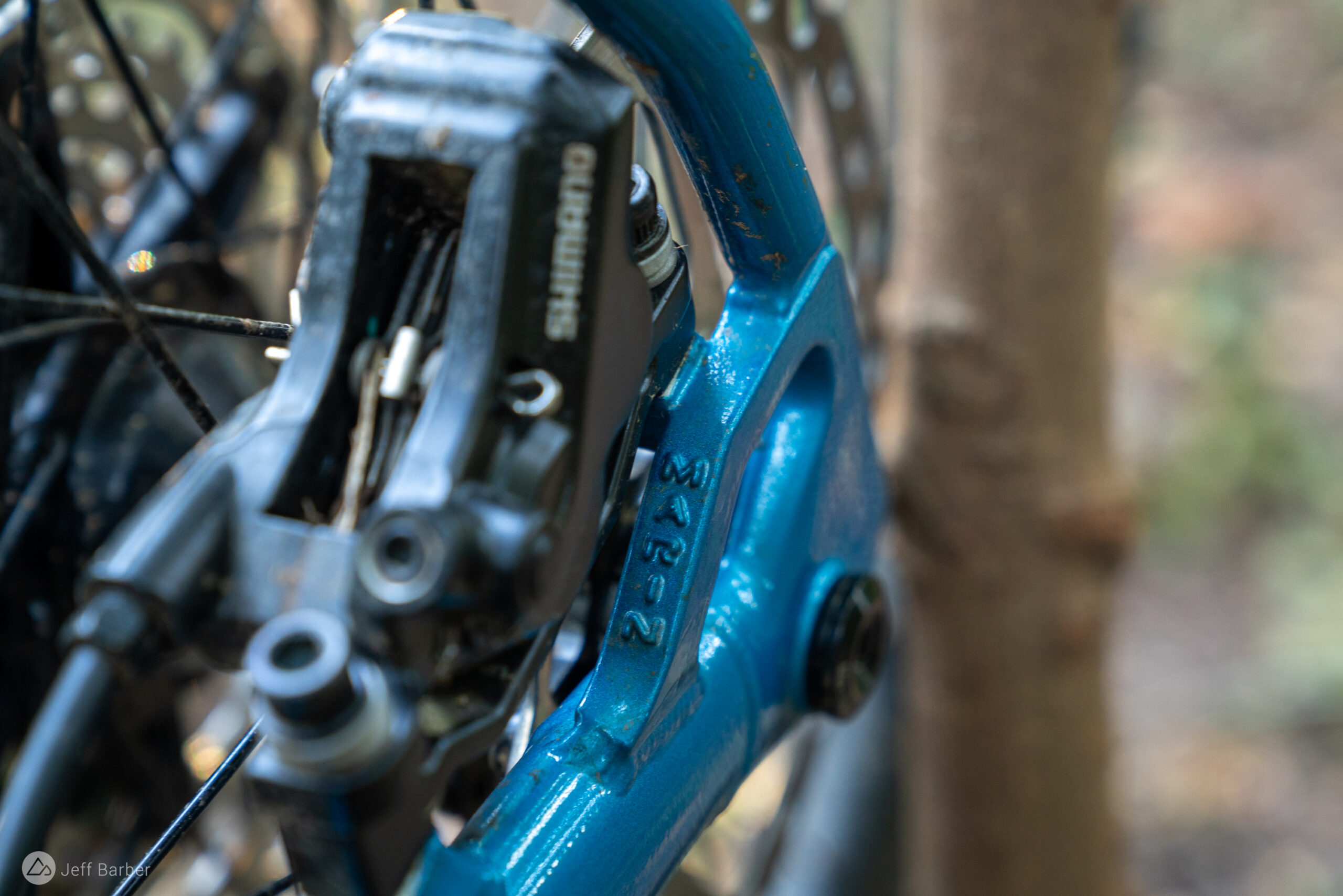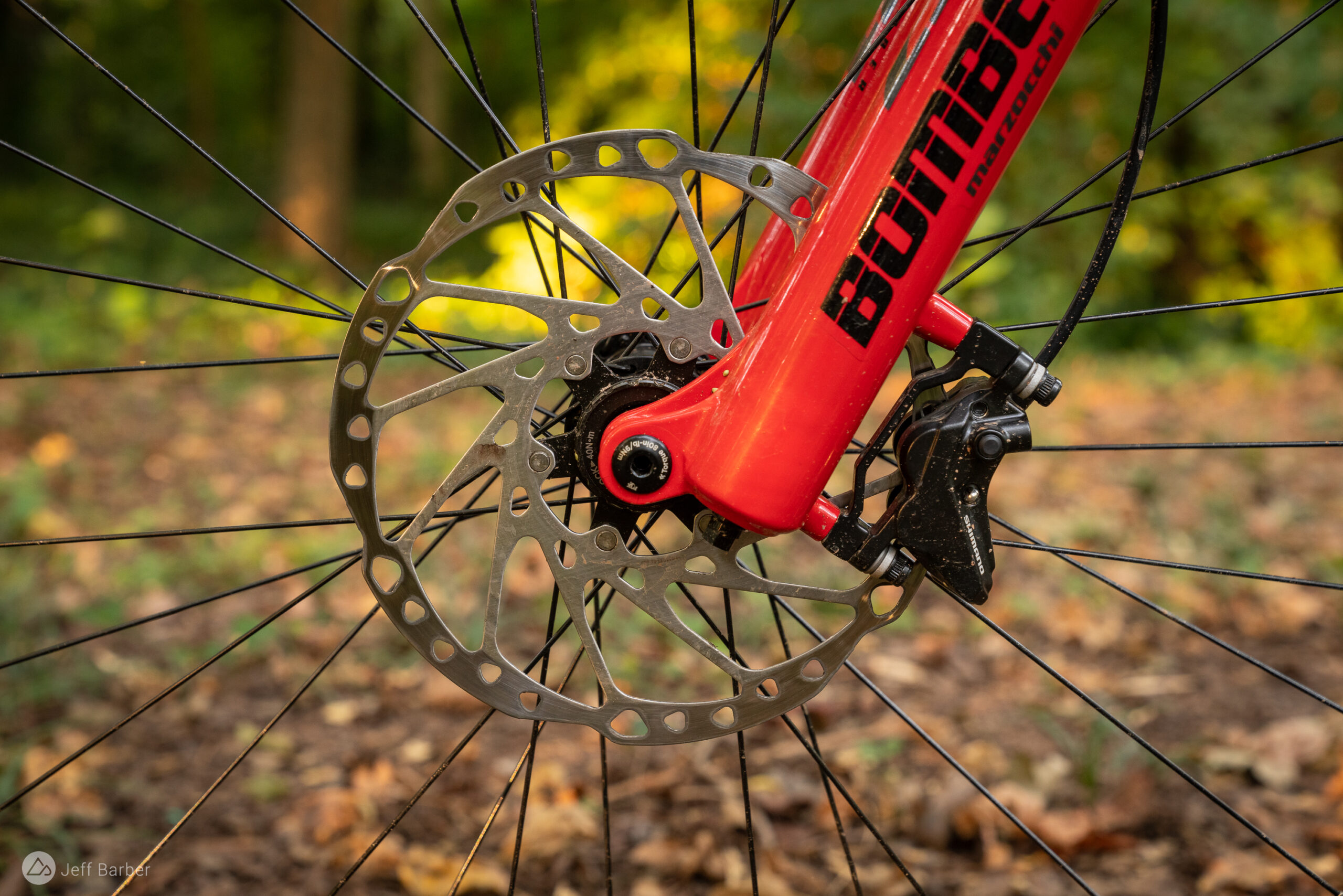
Marin El Roy frame and specs
Looking at the Marin El Roy geometry chart, it’s clear this is a pretty unique hardtail. Starting at the front of the bike, the El Roy lays back with a slack-for-any-tail 63° head tube angle. That’s paired with a steep 78° seat tube angle that gets even steeper with sag.
Reviewer profile height: 190cm (6’3″) weight: 75kg (165lb) testing zone: Southeast, USA
The El Roy looks long, and that’s because it is. There are just two sizes available — Regular and Grande — and the Grande I tested sports a 510mm reach. That’s not quite the longest bike I’ve tested this year, though it is notable given the bike’s reasonable standover height and the fact that Marin says riders 5’10” and taller should fit just fine. The front triangle looks particularly stretched in proportion to the shortish, 435mm chainstay length.
Marin El Roy geometry chart
| Regular | Grande | |
| STACK | 645 | 645 |
| REACH | 480 | 510 |
| HEADTUBE ANGLE | 63° | 63° |
| HEADTUBE LENGTH | 120 | 120 |
| SEATTUBE ANGLE | 78° | 78° |
| SEATTUBE LENGTH | 420 | 430 |
| TOPTUBE EFFECTIVE | 617 | 647 |
| BB HEIGHT | 318 | 318 |
| BB DROP | 65 | 65 |
| CHAINSTAY | 435 | 435 |
| WHEELBASE | 1252 | 1282 |
| STANDOVER HEIGHT | 735 | 743 |
| FORK OFFSET | 44 | 44 |
| SEATPOST DIAMETER | 30.9 | 30.9 |
| HANDLEBAR WIDTH | 800 | 800 |
| STEM LENGTH | 35 | 35 |
| CRANK LENGTH | 170 | 170 |



The frame is constructed using butted, chromoly steel tubing with mounts for a water bottle on the downtube and an accessory mount underneath the top tube. The derailleur cable and rear brake hose are both externally routed for easy setup and maintenance, while the seat tube has an internal routing port for a dropper post. There are no bottle mounts on the seat tube even though there’s room, presumably because they would interfere with seatpost fitment.
Rounding out the frame setup, there’s a drop-in, integrated headset and threaded bottom bracket. Naturally the rear end is Boost-spaced and features a post mount for the brakes.
The build kit
There’s only one build kit available for the El Roy, though Marin also sells the frame by itself for $699. In my opinion Marin did a nice job with this build, generally speccing quality parts that you’d find on a more traditional enduro frame. Well, except for the fork.

Don’t get me wrong, the Marzocchi Z1 is an absolutely Bomber fork (see what I did there?) but with just 140mm of travel, this isn’t the fork you’ll find on an enduro race bike. The El Roy is a hardtail after all, and in my opinion a 160mm+ fork tends to write checks that a rigid rear end just can’t cash. The upshot is the Z1 is super burly and can be set up to take some pretty big hits without bottoming out too quickly.


Marin specs 4-piston Shimano brakes front and rear, and at the fork the brake is grabbing massive 203mm rotors, with a 180mm plate in the rear. All of that stopping power is transferred to DH-approved, 2.5-inch Maxxis Assegai tubeless tires. Marin even made sure to spec the Double Down version of the Assegai in the rear to reduce the chance of flats.


The El Roy comes with a Shimano Deore 12-speed drivetrain paired with a 32T FSA Comet crankset and a blended Marin / Shimano alloy wheelset featuring 29mm-wide rims. The cockpit is mostly a blend of Marin-branded parts, with 780mm-wide handlebars that feature a 28mm rise and a 35mm clamp diameter. The size Grande model I tested comes with an X-Fusion dropper post that has 170mm of travel, while the dropper post on the Regular size has 150mm of travel.
All told the Marin El Roy I tested weighs 15.6kg (34.4lb) with pedals.
On the trail

All things considered, the Marin El Roy is a pretty weird err… unique bike, at least based on the specs. I assumed it would be a fun bike for getting rowdy, but figured it would be awkward and wonky to pedal, especially uphill. My first test ride seemed to confirm as much; the steering felt gangly while handling tight corners reminded me of driving a boat.
By the second ride, the bike felt fast and capable. By the third ride, I was scheming about buying the bike from Marin so I could keep it forever. Now, about two months and a dozen plus rides into my test, I’ve settled somewhere in between thinking the bike is weird and thinking that it’s the best bike ever. Color me respectfully impressed.
Descending prowess
The Marin El Roy has clearly been optimized for descending, and it’s hard to imagine improving its downhill capabilities short of adding a rear shock. On steep trails the bike feels composed thanks to the slack head angle, and not tippy at all. The steering remains fluid, almost ski-like, slashing the trail on command.
On more moderate slopes where it’s possible to sustain faster speeds, the El Roy feels firmly planted, particularly so for a hardtail. Since I’m not a racer I sometimes forget that suspension doesn’t just exist for my comfort; it’s also meant to provide control and keep the tires tracking over rocks and roots in the trail. Hardtails like the El Roy are at a bit of a disadvantage when it comes to rear wheel tracking, but this bike makes up for it with a compliant steel frame, high-volume tires, and a beefy — but not too long — fork up front. Overall the El Roy does a great job handling fast, technical lines, so much so that there were times that I forgot I was riding a hardtail.

The Marin El Roy is a pretty long bike overall, but most of that is in the reach, leaving the chainstay length toward the playful end of the scale. Once I got a feel for the bike I was able to adjust my cornering stance to improve handling on tight trails and acute-angle switchbacks. The upshot is the bike actually corners well despite its length, and because it’s a hardtail, it ends up being easier to style out with wheelies and nose pivots.
Surprisingly I struggled with the Assegai tires. For sure a well-regarded gravity tire, I never felt 100% confident when cornering, and pedaling felt slow and draggy. Okay, I’m not all that surprised about the second part — it is a gravity tire after all — and on the first point, I think the problem may lie with the rims Marin specs. Maxxis recommends a 35mm rim width for the Assegai Wide Trail tires, while the Marin rims are 29mm wide. Through testing many tires over the years I’ve found that even just a couple millimeters of rim width can make a big difference in the shape and width of a tire once it’s mounted.

At some point during testing I broke a spoke on the rear wheel, right at the nipple. I don’t know when or how it happened, and it’s not really fair to read too much into a single broken spoke anyway. Hardtails, and especially hardcore ones, tend to be tough on rear wheels, and fortunately the rear Assegai tire with Maxxis Double Down casing held up to my abuse without a single burp or flat.
I know I sound like a broken record when it comes to dropper post travel but here goes again: I’d love to have a longer travel dropper post than the included 170mm X-Fusion. To be fair, this is more of a “me” problem based on my height (I know, tall people problems) but the El Roy would handle descents even better if I was able to get lower on the bike. Fortunately dropper posts are cheap these days, and the included remote is decent enough that I would keep it to save some cash on the upgrade.

Climbing
When it comes to enduro bikes, product designers generally work to make sure the bike doesn’t totally suck at climbing. If a bike does truly suck at climbing, then it’s a downhill bike I guess. Well, I can confidently say the Marin El Roy does not suck at climbing. Actually it’s a pretty decent climber, and probably gets the job done better than most full suspension enduro bikes.
Back to my first impressions, it took some getting used to how the El Roy handles tight trails, but the front end never felt unweighted or wandery on the climbs thanks to the steep seat angle. Seriously, I’m sure a lot of full suspension enduro riders are looking at the 78° (un-sagged!) seat tube angle and are feeling jealous. It goes without saying that the climbing platform is solid, though at 34+ pounds this is a heavy bike for going uphill.

I found plenty of traction on technical climbs mainly thanks to the high volume tires. The El Roy doesn’t feel super rebound-y on the descents or the climbs, staying planted much like a race-tuned, full-suspension enduro bike.
On the flats the Marin El Roy rides slower than other hardtails I’ve tested, and takes more effort to get — and stay — rolling. Obviously the tires are a contributing factor in terms of weight and resistance, as are the presumably heavy wheels. I suspect the forward geometry plays a role too, with a slight bias toward front weighting the bike even on relatively flat terrain.
Final impressions
The Marin El Roy is just about as dialed as a hardtail can be for descending fast, or descending steep, or both. The flip side is the El Roy doesn’t climb as well as less aggressive hardtails. Aside from the wheels the build kit is spot on for its intended use, and offers a ton of value at this price point. I give the El Roy style points as well for its steel frame construction and glossy blue and red paint job.
- Price: $2,499.
- Buy from JensonUSA and marinbikes.com, or your local Marin dealer.
Party laps
- Very capable descender, especially for a hardtail
- Stylish frame and build kit
- Good value
Pros and cons of the Main El Roy
Dirt naps
- Heavy for a hardtail
- Rims are too narrow
- Slow pedaling





















2 Comments
Oct 5, 2022
Oct 3, 2022
Not too shabby tho'. Steel is a good option.